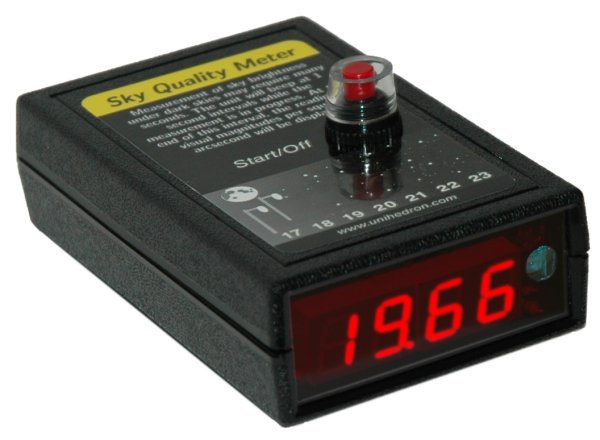The giant 20x80 binocular from Bresser is an interesting optical resource. Since it is very easy to handle it could be a good option for a quick observing session. Also, it's very affordable depending on where are you going to get it.
The most noteworthy feature from my point of view is that it is Fully multi-coated (FMC). This kind of coating can only be found in expensive binoculars. For example, the Celestron Skymaster 20x80 is "just" Multi-coated (MC). The main difference between FMC and MC type of coating is that the FMC provides higher levels (90-95%) of light transmission since all glass surfaces have multiple coatings resulting in increased bright, sharp and contrast.

Bresser 20x80 package content:
- 1x user manual (two pages per language)
- 1x nylon carrying case
- 1x carrying strap
- 1x shammy
- 3x rubber lens covers
You could find its main features (from Bresser home page) at the bottom of this post.

Not a big binocular, as can be seen comparing to my buddy.
Tripod shoe is not included in the package.
You are going to need a tripod, not a very expensive one, but a tripod that can hold no less than 3 kg weight. I use the Ultralyt 6097 tripod and it's perfect also for this binocular:
The Bresser 20x80 is not very big, but you'll need a tripod to hold it.
One of the biggest worries when buying optical elements through the Internet is the shipping because sometimes the package is not well-managed during the transport. Or maybe they were shipped out from the factory with collimation problems. In my case, it came perfectly collimated (wow!); but just in case, and for sure for future occasions, here you are How to collimate your binocular. In the next picture you could find were the collimation screws are:

Please be so careful when adjusting the collimation screws. Read carefully the previous link "how to collimate your binocular".
Testing optics:
Stars do not appear as punctual as I would wished. In addition, there is a significant image distortion, "stretching the stars" when moving out from the centre to the edges of the lenses.
 When observing the Moon it fills more than of the 40% of Field of View (FOV). Very good contrast and sharpness and also very low and acceptable chromatic aberration.
When observing the Moon it fills more than of the 40% of Field of View (FOV). Very good contrast and sharpness and also very low and acceptable chromatic aberration.Moon craters and seas appear in a magical and beautiful image.
The Moon terminator reveals the wonderful structures and reliefs thanks to sunlight and the illuminated and dark zones contrasts.
Remarkable chromatic aberration in the edges as well.
Saturn's rings are visible (no rings division are, obviously) and three of its moons as well. Lovely image for this modest equipment.
When it comes to deep space, it has a good enough performance. Good images in the centre and high contrasted as well. For wide-field objects, also good performance and clear images except in the edges where distortion is significant. Messier 31, Andromeda Galaxy, appears as a soft cloud and it covers almost the whole FOV.
Open star clusters such as Messier 44 (NGC 2632), covers almost the whole FOV.
Messier 13, the Hercules Cluster, is no more than a little cloud. No stars can be resolved.
Wishing to point to Sagittarius constellation and the Milky Way to test it with objects like Messier 8, Lagoon Nebula (NGC 6523) and, especially, Messier 20, Trifid Nebula (NGC 6514). Both are still very low in the horizon and must wait until late summer to be in an optimal position.
My own personal feedback:
This binocular is a good choice if your are not willing to pay lots of money for an entry-level binocular for astronomy. It is well built and has a decent performance for the price. Also it's very easy to handle and not too heavy so it can be held by using a cheap tripod.
For me it is very interesting the fact that despite of being a Fully multi-coated, something unusual at this price level, it has a significant chromatic aberration. Nevertheless, I think that you get what you paid for.
Well, I will be very happy if you could share with me your own feedback and, of course, any comment or review of the information of this post :)
Thanks for reading!!
Daniel Escudero
Bresser Spezial-Astro 20x80 features:
| FIELD OF APPLICATION | |
|---|---|
| Field of application |
|
| TYPE | |
| Type | Standard Binoculars |
| OPTICAL SPECIFICATIONS | |
| Optical design | Porro |
| Magnification | 20 fixed |
| LE Eyepieces | ✓ |
| Objective diameter | 80 mm |
| Material prismn | BaK-4 |
| Type of coating | Fully multi-coated |
| Colour of coating | Violet |
| Eyepieces for eyeglass wearers | ✓ |
| Diopter setting | ✓ |
| Field of view at 1000m7 | 56 m (3,2º) |
| Light intensity7 | 16 |
| Twilight factor7 | 40 |
| Near focus from7 | 9 m |
| GENERAL TECHNICAL DATA | |
| Bag/Pouch | nylon carrying case with carrying strap |
| Tripod adapter thread | ✓ |
| Focusing system | Central focus wheel |
| Eyecups | Rubber eyecups, foldable |
| Colour | black |
| Body material | Aluminium |
| Body armouring | Rubber/Plastic |
| Warranty | 5 Years |
| DIMENSIONS & WEIGHTS | |
| Total length | 330 mm |
| Total width | 235 mm |
| Total height | 108 mm |
| Net weight (without access.) | 2100 g |





